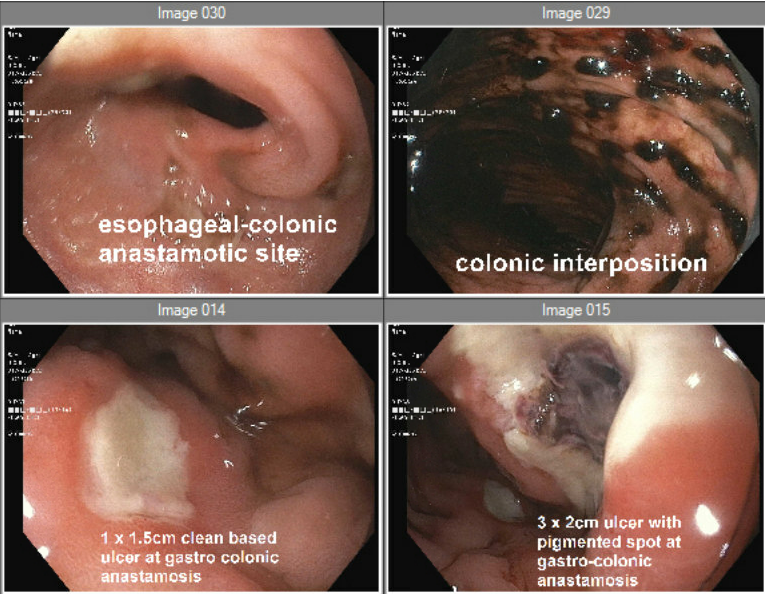Sunday Poster Session
Category: Colorectal Cancer Prevention
P0532 - When the Graft Bleeds: Tubular Adenoma in a Young Adult with Colon Interposition
Sunday, October 26, 2025
3:30 PM - 7:00 PM PDT
Location: Exhibit Hall

Abdulrahman Atasi, MD (he/him/his)
One Brooklyn Health-Brookdale University Hospital Medical Center
Brooklyn, NY
Presenting Author(s)
Abdulrahman Atasi, MD1, Wihad Alsamman, MD1, Javed Jagroo, MBBS2, Sharanya Nemakallu, MD1, Nader Daoud, MD3, Chidiebele Omaliko, MD1, Harry Moussouris, MD1, Derrick Cheung, MD3
1One Brooklyn Health-Brookdale University Hospital Medical Center, Brooklyn, NY; 2Brookdale University Hospital Medical Center, Ozone Park, NY; 3Brookdale University Hospital Medical Center, Brooklyn, NY
Introduction: Colonic interposition for esophageal resection is a surgical procedure in which a segment of colon replaces a resected esophagus. Chronic exposure of the interposed colon to gastric reflux, with altered microbiota, and prolonged transit time is believed to contribute to mucosal injury and development of dysplasia, which increases the risk of neoplastic transformation. Case reports have shown both benign lesions like tubular adenomas, and malignant neoplasms like adenocarcinoma which arose years after surgery.
Case Description/
Methods: A 29-year-old male presented to the hospital after losing consciousness. He reported feeling lightheaded while walking with friends and then woke up covered in dark black stool. He had a past medical history of premature birth, esophagectomy with colon interposition, hypertension, substance use disorder, and seizures. On arrival, his vital signs were within normal limits and his hemoglobin was 13.2 g/dL. He experienced two additional episodes of melena in the emergency department raising concern for upper gastrointestinal bleeding. A computed tomography angiogram of the abdomen pelvis with contrast showed no evidence of active bleeding. Esophagogastroduodenoscopy revealed altered esophageal anatomy consistent with the history of esophagectomy with colonic interposition graft, a 1 x 1.5 cm clean based ulcer and a 3 x 2 cm ulcer with pigmented spot at ulcer base noted at the anastomotic site of the colonic interposition graft and the gastric antrum, and mild gastritis. Biopsies were obtained from the ulcer and the antrum. No active bleeding noted, and no other endoscopic intervention was performed. Anastomotic site biopsy showed colonic mucosa with tubular adenoma, antrum biopsy showed no evidence of Helicobacter pylori
Discussion: Detection of tubular adenomas in the interposed colon highlights the importance of routine screening in these patients, as early identification and removal can prevent progression to malignancy. There are no guidelines for surveillance of the interposed colon; recommendations are often derived from colorectal cancer screening protocols. Some experts suggest performing upper endoscopy of the interposed segment during routine colonoscopies and advocate for lifelong surveillance. This case highlights the importance of surveillance and patient education in individuals with colon interposition, to enable early detection and intervention despite the absence of standardized guidelines.

Figure: Images from the esophagogastroduodenoscopy show colonic interposition and two ulcers at the gastro-colonic anastomosis

Figure: Anastomotic biopsy showing a tubular adenoma composed of small uniform appearing low grade dysplastic gland structures at 100x magnification light microscope
Disclosures:
Abdulrahman Atasi indicated no relevant financial relationships.
Wihad Alsamman indicated no relevant financial relationships.
Javed Jagroo indicated no relevant financial relationships.
Sharanya Nemakallu indicated no relevant financial relationships.
Nader Daoud indicated no relevant financial relationships.
Chidiebele Omaliko indicated no relevant financial relationships.
Harry Moussouris indicated no relevant financial relationships.
Derrick Cheung indicated no relevant financial relationships.
Abdulrahman Atasi, MD1, Wihad Alsamman, MD1, Javed Jagroo, MBBS2, Sharanya Nemakallu, MD1, Nader Daoud, MD3, Chidiebele Omaliko, MD1, Harry Moussouris, MD1, Derrick Cheung, MD3. P0532 - When the Graft Bleeds: Tubular Adenoma in a Young Adult with Colon Interposition, ACG 2025 Annual Scientific Meeting Abstracts. Phoenix, AZ: American College of Gastroenterology.
1One Brooklyn Health-Brookdale University Hospital Medical Center, Brooklyn, NY; 2Brookdale University Hospital Medical Center, Ozone Park, NY; 3Brookdale University Hospital Medical Center, Brooklyn, NY
Introduction: Colonic interposition for esophageal resection is a surgical procedure in which a segment of colon replaces a resected esophagus. Chronic exposure of the interposed colon to gastric reflux, with altered microbiota, and prolonged transit time is believed to contribute to mucosal injury and development of dysplasia, which increases the risk of neoplastic transformation. Case reports have shown both benign lesions like tubular adenomas, and malignant neoplasms like adenocarcinoma which arose years after surgery.
Case Description/
Methods: A 29-year-old male presented to the hospital after losing consciousness. He reported feeling lightheaded while walking with friends and then woke up covered in dark black stool. He had a past medical history of premature birth, esophagectomy with colon interposition, hypertension, substance use disorder, and seizures. On arrival, his vital signs were within normal limits and his hemoglobin was 13.2 g/dL. He experienced two additional episodes of melena in the emergency department raising concern for upper gastrointestinal bleeding. A computed tomography angiogram of the abdomen pelvis with contrast showed no evidence of active bleeding. Esophagogastroduodenoscopy revealed altered esophageal anatomy consistent with the history of esophagectomy with colonic interposition graft, a 1 x 1.5 cm clean based ulcer and a 3 x 2 cm ulcer with pigmented spot at ulcer base noted at the anastomotic site of the colonic interposition graft and the gastric antrum, and mild gastritis. Biopsies were obtained from the ulcer and the antrum. No active bleeding noted, and no other endoscopic intervention was performed. Anastomotic site biopsy showed colonic mucosa with tubular adenoma, antrum biopsy showed no evidence of Helicobacter pylori
Discussion: Detection of tubular adenomas in the interposed colon highlights the importance of routine screening in these patients, as early identification and removal can prevent progression to malignancy. There are no guidelines for surveillance of the interposed colon; recommendations are often derived from colorectal cancer screening protocols. Some experts suggest performing upper endoscopy of the interposed segment during routine colonoscopies and advocate for lifelong surveillance. This case highlights the importance of surveillance and patient education in individuals with colon interposition, to enable early detection and intervention despite the absence of standardized guidelines.

Figure: Images from the esophagogastroduodenoscopy show colonic interposition and two ulcers at the gastro-colonic anastomosis

Figure: Anastomotic biopsy showing a tubular adenoma composed of small uniform appearing low grade dysplastic gland structures at 100x magnification light microscope
Disclosures:
Abdulrahman Atasi indicated no relevant financial relationships.
Wihad Alsamman indicated no relevant financial relationships.
Javed Jagroo indicated no relevant financial relationships.
Sharanya Nemakallu indicated no relevant financial relationships.
Nader Daoud indicated no relevant financial relationships.
Chidiebele Omaliko indicated no relevant financial relationships.
Harry Moussouris indicated no relevant financial relationships.
Derrick Cheung indicated no relevant financial relationships.
Abdulrahman Atasi, MD1, Wihad Alsamman, MD1, Javed Jagroo, MBBS2, Sharanya Nemakallu, MD1, Nader Daoud, MD3, Chidiebele Omaliko, MD1, Harry Moussouris, MD1, Derrick Cheung, MD3. P0532 - When the Graft Bleeds: Tubular Adenoma in a Young Adult with Colon Interposition, ACG 2025 Annual Scientific Meeting Abstracts. Phoenix, AZ: American College of Gastroenterology.
